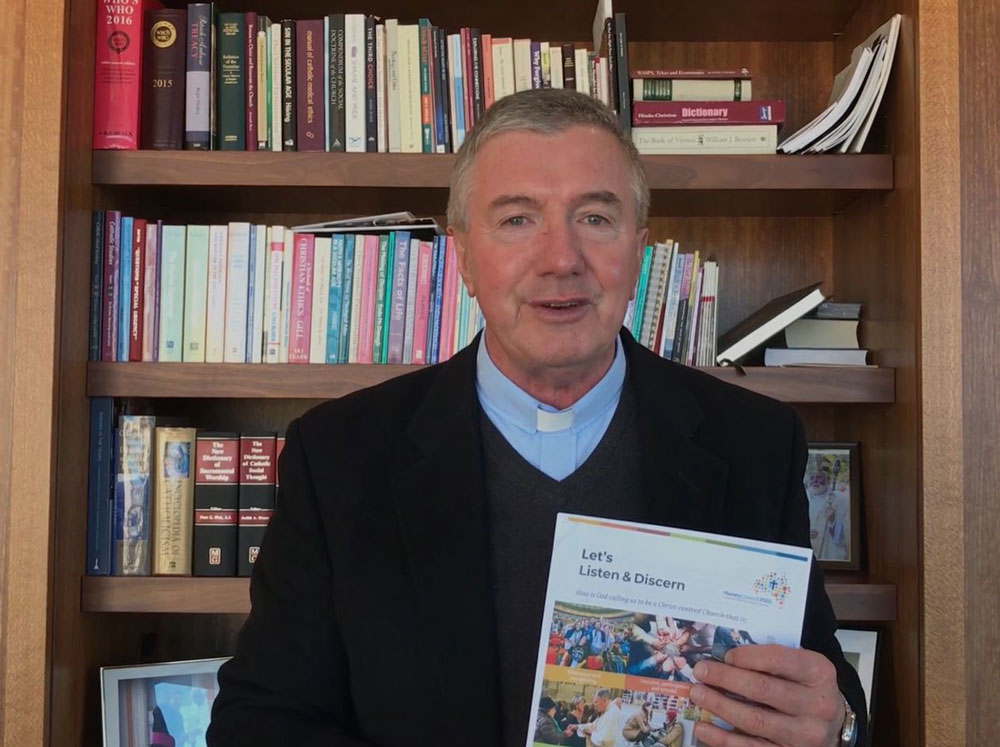Archbishop emphasises need for discernment in second Plenary phase

Archbishop Christopher Prowse
As the second phase of the Plenary Council process gets under way, Archbishop Christopher Prowse has emphasised the key role of discernment.
“The second phase is about listening and discerning,” he said.
“So the first phase was about listening and asking the big question, what do you think God’s doing in the Church of Australia today… and we continue to ask that… but now we start to discern. What is of God, and what is not of God.”
Archbishop Christopher invited Catholics across the Archdiocese of Canberra and Goulburn to regroup in their Deaneries and parishes under the direction of Deans and facilitators.
“It might be in Parishes, it might be in a big Deanery group, it might be in a school group it might even be in a family group. It can be done at all sorts of levels,” Archbishop Christopher explained.
“And we’ve been given a structure for the way these groups are to function. It’s a very simple way of praying together the scriptures at the start, we reflect together, we listen and we share, and then we start making some distinctions that are important in discerning, about what we could respond to and what perhaps we may not respond to… to begin to discern.”
After these sessions, each group will be asked to write a small summary of around 150 words or so of the outcome of their discernment and then send it in to the Plenary office in Brisbane where the reports will be collected and reviewed.
The second phase Plenary sessions will deal with the six themes or topics that emerged from the first phase. The topics discuss the Church as being:
- Missionary and evangelising
- Inclusive, participatory and synodal
- Humble, healing and merciful
- Prayerful and Eucharistic
- Joyful, hope-filled and servant of the community
- Open to conversion, renewal and reform
Archbishop Christopher pointed out that each session would not discuss all of the topics.
“When a group meets they choose one of these six, not the whole six, and the document provided goes on to discuss the way of prayerful discernment on that particular focus point,” he said.
“So as your Archbishop I encourage you to regroup over the next few months and enter as many submissions as you would like to see where God is moving in the great country of Australia … particularly in the Catholic Church in these troubled but very hopeful times.”
RELATED LINKS:



Come Divine Will bless Australia xox
In this August edition, Archbishop Christopher indicates the critical importance of discernment and listening in the next stage of the Plenary Council processes. He also highlights a central challenge: “what we could respond to and what perhaps we may not respond to.”
How is conflict resolved when there are conflicting priorities and views?
The National Council of Priests, for instance, supports a proposal for married priests in remote parts of Australia where lack of priests is a long-standing issue. In contrast, Pope Francis did not reconfirm Cardinal Gerhard Muller for a second five-year term as prefect of the Congregation for the Doctrine of the Faith yet his theology envisages eternal damnation to Hell for those who die in mortal sin; rejects divorcees receiving the Eucharist; defends priestly celibacy in terms of ‘self-giving in the service of Christ; bridles about the term ‘clericalism’; excludes women from the diaconate and priesthood; and believes attempts to change ‘Humane Vitae’ are a ‘crime against the Church’.
As well as being Christ’s Church on earth, and the people of God, the Catholic Church is a hierarchical, top-down institution and it would be difficult to argue that it is a democracy. So precisely how does one assess such relative viewpoints, ‘discern’ and respond to the writings of a senior Cardinal in the Church as opposed to pastoral priests working in Australian parishes?
How does one determine “what perhaps we may not respond to”?